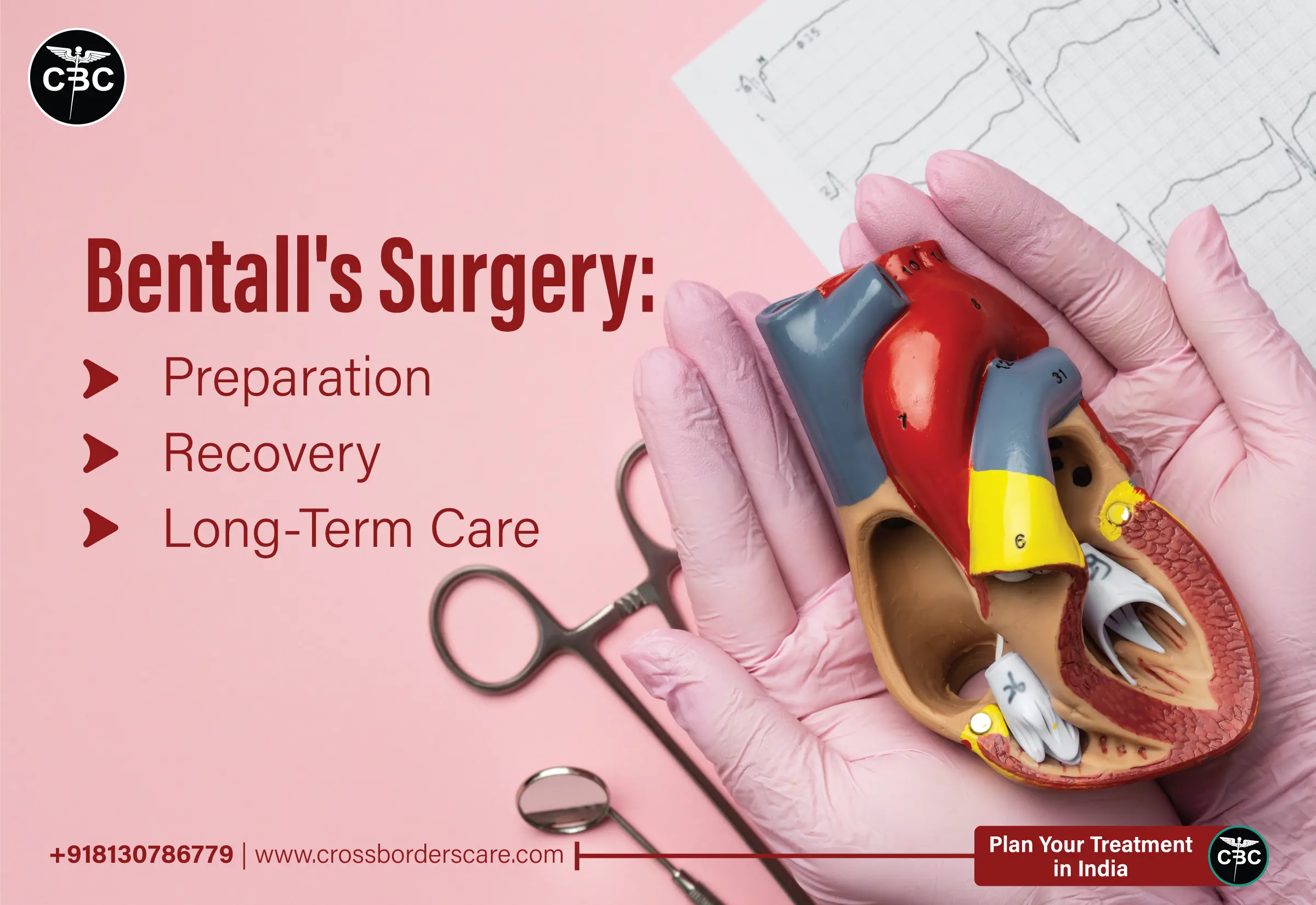The Bentall surgery, commonly referred to as the Bentall procedure, is a sophisticated cardiac surgical treatment used to address a variety of diseases that affect the aorta and aortic valve. It includes synthetic or biological replacements for the aortic root, aortic valve, and ascending aorta. This procedure is usually used to treat aortic aneurysms and aortic valve problems simultaneously. This technique successfully treats both the aortic root and valve problems, increasing overall heart function and lowering the risk of complications related to aortic disorders. The choice of valve and graft material is made depending on the patient’s health and the surgeon’s preference. Bentall surgery in India is an entirely safe procedure that has helped thousands of patients.
The procedure of the Bentall Surgery
It involves replacing the aortic root, the aortic valve, and the ascending aorta. The steps of the Bentall surgery are described below:
● Anesthesia: The patient is put under general anesthesia before surgery. This guarantees that the patient will be asleep and pain-free during the procedure.
● Make an Incision: The surgeon makes A significant incision in the chest, usually via a median sternotomy. To access the heart and aorta, one must cut through the sternum, the bone that forms the breastbone. This opens up the heart and gives a clear glimpse of it.
● Cardiopulmonary Bypass (CPB): The patient is connected to a heart-lung machine (CPB) to complete the procedure. The heart can be operated on without the requirement for blood circulation since this device temporarily takes over the activities of the heart and lungs.
● Aortic Root Removal: The surgeon removes the damaged segment of the aorta, including the aortic valve and any weakening or aneurysmal tissue. This usually involves dividing the coronary arteries and removing the aortic valve.
● Replacing the aortic valve: A prosthetic valve is inserted to replace the removed aortic valve during aortic valve replacement. Mechanical (made of metal) or biological (often from a pig or cow, medicated to prevent rejection) valves are also options. The replacement valve is firmly stitched into position.
● Aortic Graft Placement: The excised aortic root and ascending aorta are replaced with a synthetic tube (graft), frequently composed of materials like Dacron. The new prosthetic valve is attached to this graft by sewing it in place. The previously separated coronary arteries are re-implanted into this transplant to ensure they receive blood flow.
● Closure: After ensuring the prosthetic valve and graft are securely in place, and blood usually flows via the coronary arteries, the surgeon sews up the chest incision. The sternum may need to be tightly closed using wires or other surgical supplies.
● Weaning from CPB: When a patient has weaned off a heart-lung machine, their heart can start pumping blood again.
● Monitoring and Recovery: Following surgery, the patient is continuously watched in the intensive care unit (ICU) to ensure steady recovery.
Preparation
Preparing for a Bentall procedure is essential to ensure the patient’s safety and the operation’s success. Here’s a detailed explanation of the process:
● Medical Evaluation: The patient receives a thorough evaluation before a Bentall treatment. This includes a comprehensive review of one’s medical history and diagnostic procedures like echocardiograms, CT scans, and angiograms. These tests aim to decide whether the patient is a good candidate for surgery.
● Discussion with the Surgical Team: The patient meets with the surgical team, which includes the anesthesiologist and the cardiac surgeon, to discuss the surgery. The patient can clear any doubts, ask questions, and learn about the advantages and disadvantages of the procedure.
● Medication Modification: Before surgery, the patient’s medications may need to be modified or temporarily halted. This includes medicines that can affect anesthesia, anticoagulants, antiplatelet drugs, etc.
● Stop smoking: Patients who smoke are strongly urged to give up before surgery since it might hinder wound healing and raise the possibility of problems.
● Dental Checkup: Dental health is crucial before heart surgery since dental infections can spread to the valves. Patients might need to get their teeth checked and treated if necessary.
● Blood transfusion: If a blood transfusion is planned during or after the Bentall procedure, patients may occasionally donate their blood before surgery.
● Fasting: The patient is told to abstain from food or drink for a certain amount before surgery, usually the night before. This lessens the possibility of aspiration.
● Final Preoperative Check: On the day of the operation, the surgical team does a last preoperative check to validate the patient’s identity, confirm the surgical procedure, and ensure all necessary tools and supplies are available.
Recovery
Here are some recovery tips to consider after undergoing a Bentall surgery in India
● Hospital Stay: Depending on the patient’s health and the surgical strategy chosen, the initial recovery phase often entails a hospital stay of seven to ten days.
● Pain management: After major cardiac surgery, pain and discomfort are typical. The medical staff will administer the proper pain management, which may entail using drugs or other pain reduction methods. It is crucial to let the medical staff know how much pain you are experiencing so that they can modify your pain management strategy accordingly.
● Monitoring: Once your health has stabilised, you will be closely watched in a regular hospital rather than the cardiac critical care unit (ICU). Heartbeat, vital signs, and other factors will be carefully monitored.
● Medication: You will be given prescriptions for drugs to help you manage different elements of your rehabilitation, including pain, blood thinners to avoid clots, and medicines to help your heart operate. Follow the directions on all prescriptions.
● Wound Care: It’s essential to take care of your surgical incision. Follow the healthcare team’s recommendations for dressing changes and wound care. Keep the incision clean and dry.
● Cardiac Rehabilitation: Your healthcare provider might advise enrolling in a cardiac rehabilitation program after discharge. Through exercise, education, and dietary modifications, this structured program aids in improving your cardiovascular health.
Long-Term Care
Here are some tips on how to take long-term care after the procedure:
● Attendance at Follow-up Appointments: Show up for all scheduled follow-up consultations with your cardiologist and heart surgeon. These consultations are crucial for keeping track of your development and modifying your treatment strategy.
● Heart-Healthy Diet: Consume a heart-healthy diet low in sodium, cholesterol, and saturated and trans fats. Consume a lot of fruits, vegetables, whole grains, lean proteins, and omega-3 fatty acid-rich meals.
● Frequent Exercise: Follow your healthcare team’s recommendations and exercise regularly. Exercise helps maintain weight, enhance overall fitness, and improve cardiovascular health. Follow your doctor’s advice at all times, but begin with easy exercises and work up to more rigorous ones.
● Alcohol consumption: Limit alcohol consumption to reasonable levels because excessive alcohol can damage the heart. The same goes for caffeine. Caffeine should be consumed with caution because it can sometimes disrupt heart rhythm.
● Stress management: Use relaxation methods, mindfulness, meditation, or counselling to manage stress healthily. High levels of stress can significantly impact heart health.
As a result, Bentall surgery in India restores health and vitality to individuals with serious heart conditions by addressing aortic root and valve issues.
October 5, 2023


















